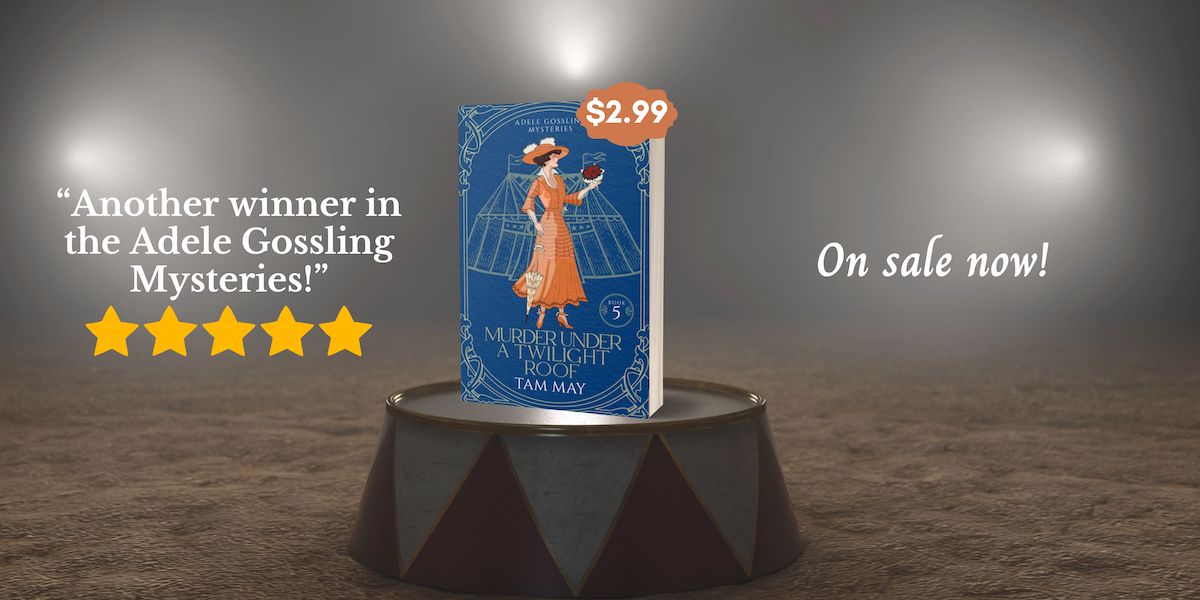
Title: Adele Gossling Mysteries Box Set 1: Books 1-3 (Adele Gossling Mysteries Box
Series: Adele Gossling Mysteries
Author: Tam May
Genres: Historical Cozy Mystery
Release Date: November 25, 2023
Can a forward-thinking woman help the police solve crimes in a backward-thinking town?
“Great new series!”
Smart, inquisitive, and a firm believer in Progressive Era reforms, Adele Gossling seeks a new life after the devastating death of her father. She flees San Francisco for the town of Arrojo, planning a life of peace and small pleasures. But both elude her when she and her spiritual sidekick, Nin Branch, get involved in helping the local police solve the case of a dead debutante, a poisoned schoolteacher, and a family matriarch who may or may not have left a generous will.
The Carnation Murder: Adele Gossling has barely been in Arrojo for a week when she discovers her neighbor’s dead body in her gazebo. Can Adele and Nin solve this puzzling case involving a striped carnation, a diamond ring, a note, a muddy pair of boots, and a broken promise?
A Wordless Death: Millie Gibb, the new teacher at the local girl’s school, is found dead and everybody in town assumes the homely, unmarried spinster committed suicide. Can Adele and her clairvoyant friend Nin prove Millie’s death was foul play based on a cigar stub, a letter fragment, and a cigarette lighter before the case is closed for good?
Death at Will: When the affluent Thea Marsh dies unexpectedly, the trail of suspects leads to Thea’s beloved and favored eldest son, Theo. Will Adele make a case against Theo’s guilt for the police out of a stained teacup, a fountain pen nib, ashes that should have been in the fireplace, and daisies that should have been fresh?
Pick up this box set of the first three Adele Gossling Mysteries and immerse yourself in turn-of-the-century Northern California in all its dynamic and chaotic glory for a fun and cozy read!
You can get your copy of this box set at a special price at the following online retailers.
About the Author

Writing has been Tam May’s voice since the age of fourteen. She writes stories set in the past that feature sassy and sensitive women characters. Tam is the author of the Adele Gossling Mysteries which take place in the early 20th century and features suffragist and epistolary expert Adele Gossling whose talent for solving crimes doesn’t sit well with the town’s more conventional ideas about women’s place. She has also written historical fiction about women breaking loose from the social and psychological expectations of their era. Although Tam left her heart in San Francisco, she lives in the Midwest because it’s cheaper. When she’s not writing, she’s devouring everything classic (books, films, art, music) and concocting yummy plant-based dishes.
Social Media Links
Facebook: https://www.facebook.com/tammayauthor/
Instragram: https://www.instagram.com/tammayauthor/
Pinterest: https://www.pinterest.com/tammayauthor/
Amazon Author Page: https://www.amazon.com/Tam-May/e/B01N7BQZ9Y/
BookBub Author Page: https://www.bookbub.com/authors/tam-may
Goodreads Author Page: https://www.goodreads.com/author/show/16111197.Tam_May







